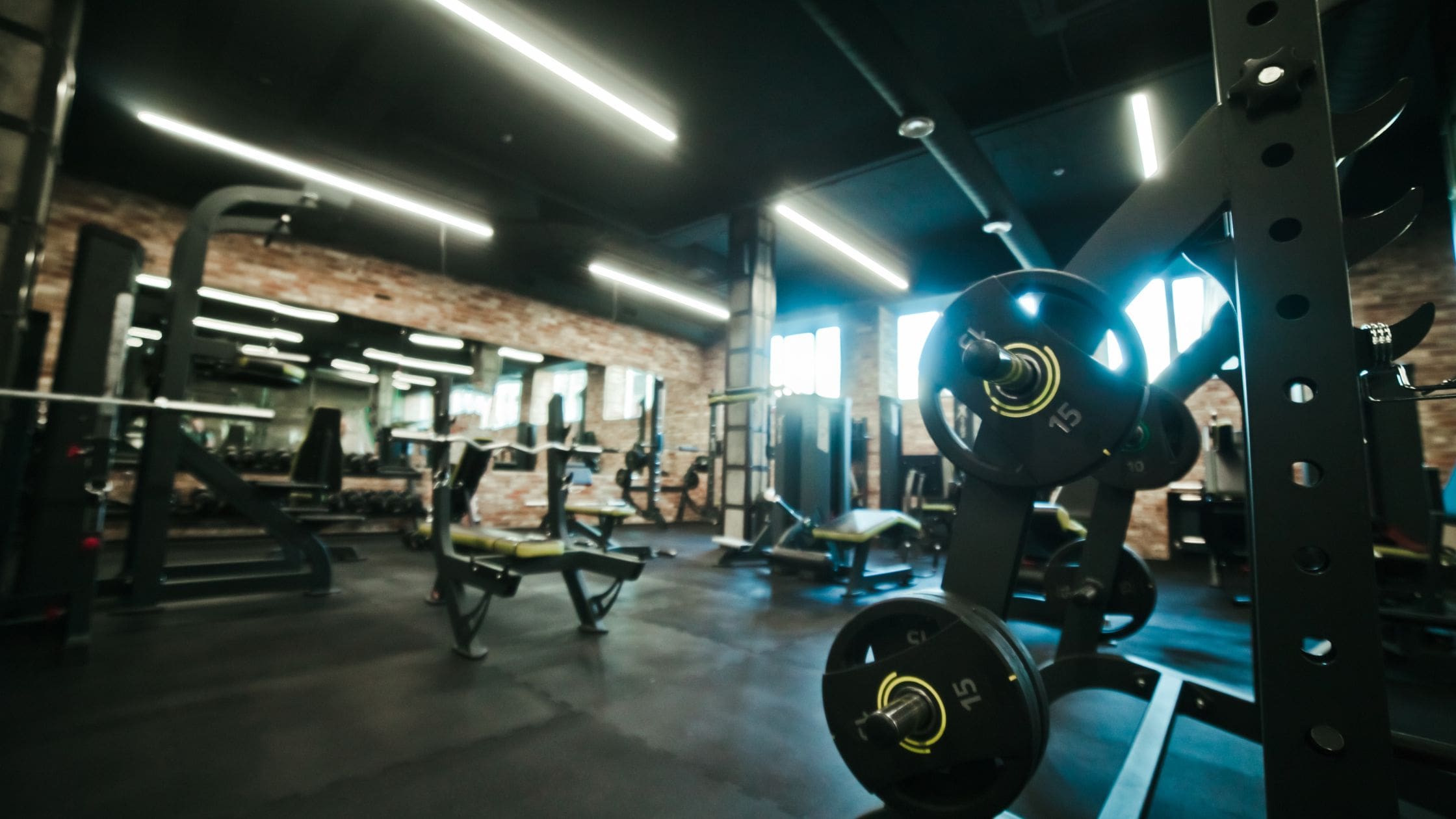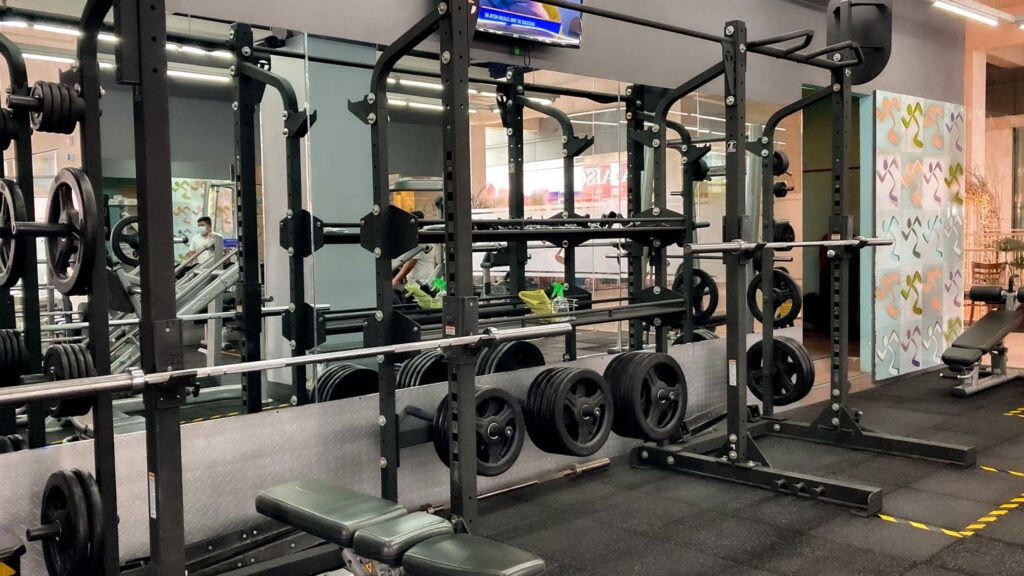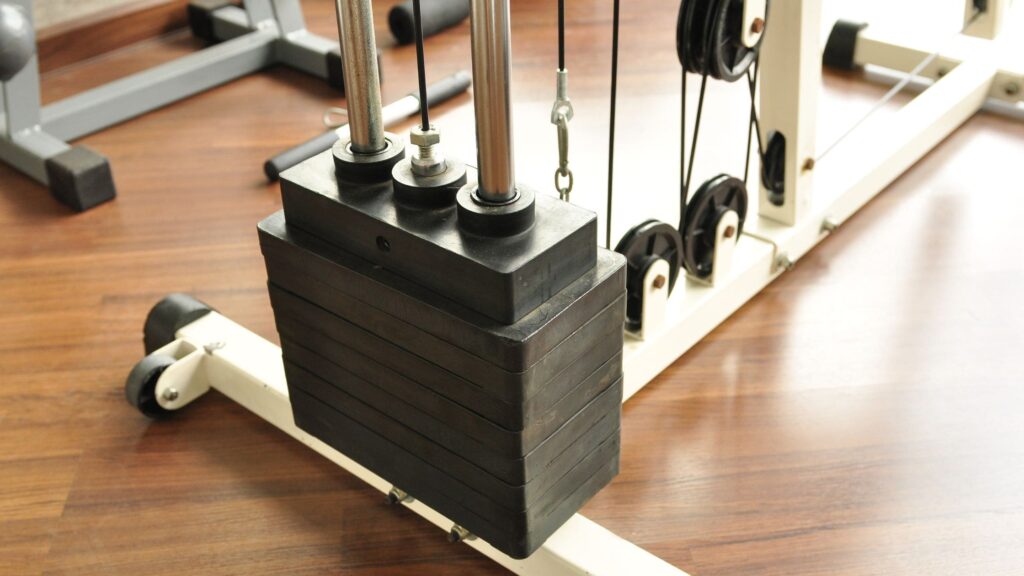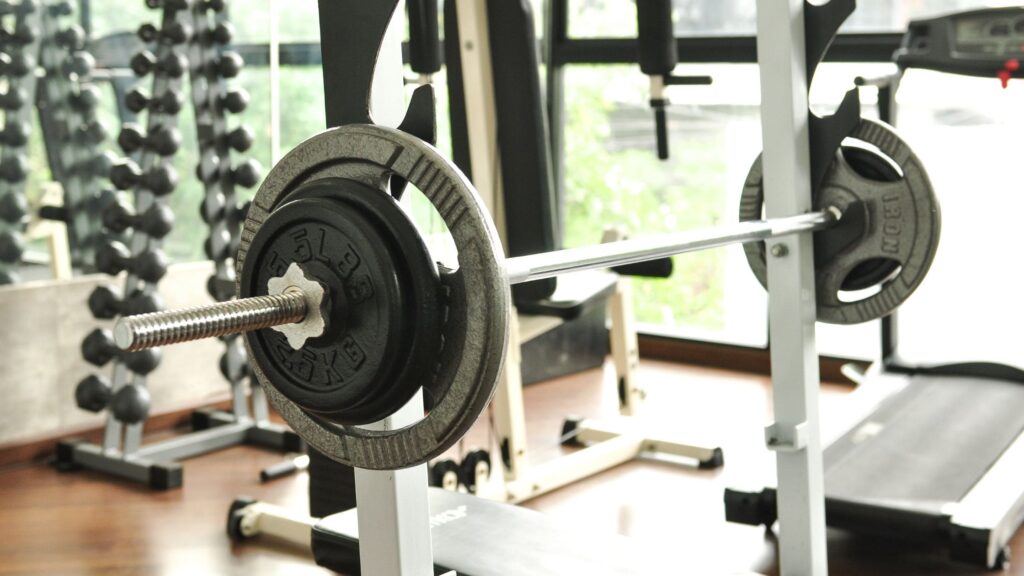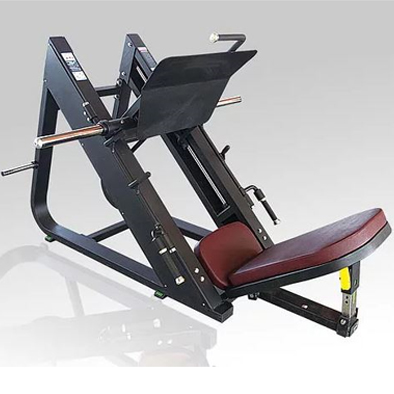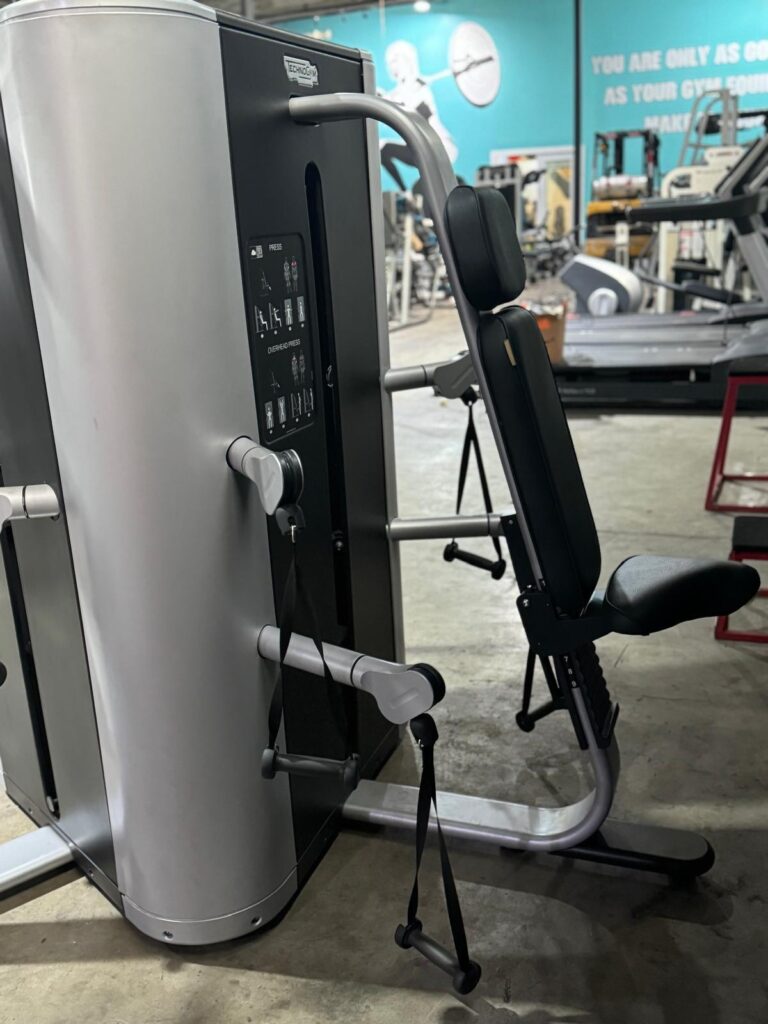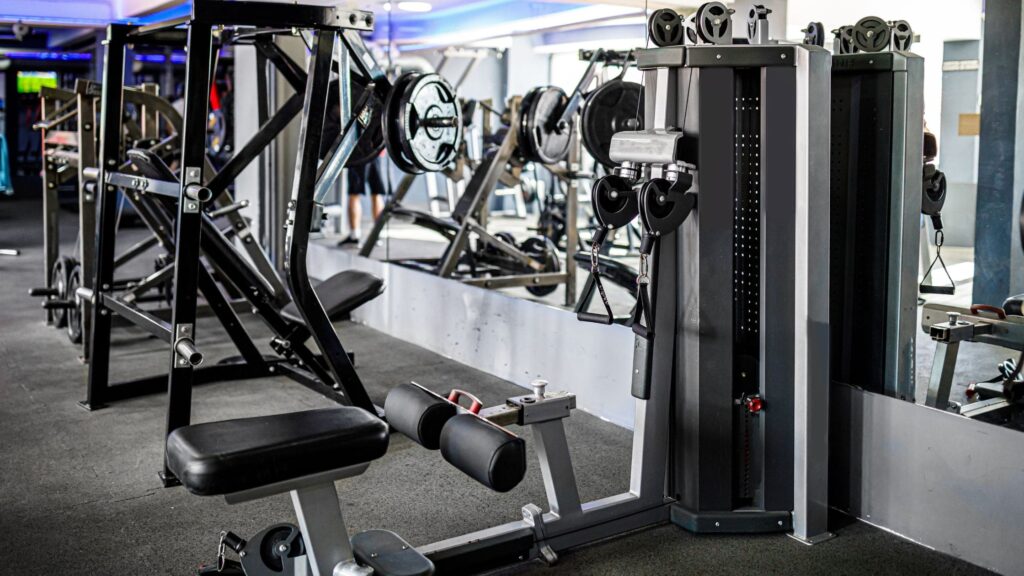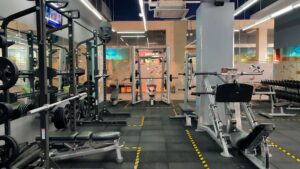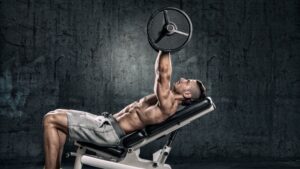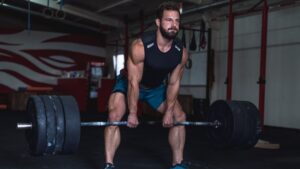Weight training machines are not just gym equipment; they’re your partners in building strength safely and effectively. Perfect for everyone, from beginners to the fitness-savvy, they’re designed to provide stability that free weights don’t, helping you focus on your training without the worry of an unexpected slip or fall.
It doesn’t matter if you’re just starting out, recovering from an injury, or looking to push your limits, weight training machines are incredibly versatile. They range from easy-to-use selectorized systems, where you pin your weight, to plate-loaded setups that allow for tailored resistance. These machines are fantastic for honing in on specific muscle groups and perfecting your form, giving you the confidence to lift heavier without the risk.
Adjustable for all shapes and sizes, they make strength training accessible and straightforward. In this article, we’ll focus on how you can get the most out of these workout wonders, ensuring you’re not just going through the motions but actually making significant strides in your fitness journey.
What Is A Weight Training Machine?
A weight training machine is an important piece of strength training equipment designed to leverage gravity-based resistance, enhanced through an array of mechanical systems including levers, pulleys, and cables. The essence of these machines lies in their ability to provide a structured movement path, significantly minimizing the risk of injury and ensuring optimal form during exercises. These machines vary from those equipped with a weight stack secured by a vertical selector pin to those that are plate-loaded, allowing users to add or remove weights according to their resistance needs. This feature is particularly engineered to simplify the adjustment of resistance, enabling a swift adaptation to the user’s strength level. It’s a common misconception that these machines are solely for beginners; in reality, even advanced lifters find immense value in the stability and targeted muscle isolation that these machines offer. Notably, some advanced models include functional selectorized machines that incorporate cables with swivel pulleys, offering a wider range of motion and the possibility for unilateral exercises, thus enhancing the training experience by making the weight feel lighter or heavier based on the pulley arrangement.
Are Weight Training Machines Better Than Free Weights?
The answer isn’t straightforward, as each type of equipment has its unique advantages tailored to different fitness goals, skill levels, and personal comfort.
Weight machines offer significant benefits such as enhanced safety, stability, and a reduced requirement for mastering technique, making them particularly advantageous for beginners or those recovering from injuries. These machines guide users into correct form, helping prevent common exercise-related injuries and allowing focused muscle isolation. For beginners, the fear of handling free weights and maintaining balance can be daunting; machines provide a structured environment where they can gain confidence without the risk of dropping weights.
Conversely, free weights are celebrated for their dynamic and functional nature. They engage stabilizer muscles and offer a broader range of motion, which is crucial for building functional strength that applies to everyday activities. Free weights challenge users to maintain balance and coordinate multiple muscle groups, providing a more comprehensive workout.
Many fitness enthusiasts and experts advocate for a combined approach where both machines and free weights are integrated into a routine. This synergy allows for the safety and muscle-specific training of machines while incorporating the functional benefits of free weights. Advanced lifters, in particular, can benefit from this combination by using machines for high-intensity or drop sets safely and free weights for compound movements and enhancing muscle coordination.
Comparison Table: Weight Training Machines vs. Free Weights
| Feature | Weight Training Machines | Free Weights |
| Safety | High (reduced risk of dropping weights) | Moderate (risk of improper lifting and balance) |
| Ease of Use | Beginner-friendly (guided movements) | Requires learning proper techniques |
| Muscle Engagement | Isolates specific muscles effectively | Engages both primary and stabilizer muscles |
| Flexibility | Fixed path of motion | Allows free range of motion |
| Skill Development | Limited impact on balance and coordination | Enhances balance, coordination, and strength |
| Variety | Often limited to specific exercises | Enables a wide range of exercises |
What are the Benefits of Using Weight Training Machines?
Weight training machines provide a multitude of benefits, making them a staple in gyms and rehabilitation centers alike. Their primary advantage is stability; by guiding the path of motion, these machines allow users to focus solely on muscle contraction rather than balancing, which significantly reduces the risk of injury. This stability is particularly beneficial in exercises where precision in muscle engagement is crucial for both safety and effectiveness.
Many weight training machines are engineered to apply the greatest amount of force when muscles are in their strongest position, thereby maximizing muscle development potential. This strategic force application is ideal for both promoting muscle growth and enhancing the overall efficiency of the workout. Additionally, these machines excel at isolating specific muscle groups, making them invaluable for correcting muscular imbalances, such as focusing intensively on one leg at a time with a leg press machine.
For beginners, older adults, or those currently in rehabilitation programs, weight training machines offer a safe environment. They minimize the risk associated with falling weights and other common gym injuries. These machines also facilitate controlled mechanical overload, allowing users to push a muscle to its limit within a safe range of motion. Similarly, they enable metabolic overload, where muscles are worked to the point of fatigue, an essential factor in muscle building.
Moreover, weight training machines are often utilized for “drop sets” — a technique involving performing an exercise to near failure, then quickly reducing the weight to continue exercising, which is an effective method for stimulating rapid muscle growth. Another notable benefit is their convenience in circuit training settings; these machines allow for quick transitions between exercises, making workouts more time-efficient and fluid.
Lastly, weight training machines can significantly boost confidence for individuals new to resistance training. They provide a less intimidating introduction to strength exercises, helping users to gradually build their competence and comfort. Overall, the structured environment of weight training machines supports essential learning patterns for foundational exercises like shoulder presses and rows, ensuring correct form and minimizing the potential for mistakes.
How Does a Weight Training Machine Work?
Weight training machines operate primarily on the principle of gravity, with modifications provided by pulleys, cables, or levers to adjust the force exerted on the user. These machines typically feature selectorized systems, where a stack of plates, each labeled by weight, can be selected through the insertion of a pin under the desired plate level, thus setting the resistance.
The weights in these stacks often average around 6 kilograms each, although this can vary depending on the machine design and manufacturer. Plate-loaded machines, such as leg presses or Smith machines, require users to manually load standard barbell plates to adjust the resistance, offering more flexibility and variability in weight.
One significant aspect of these machines is the concept of mechanical advantage. In certain plate-loaded equipment, the angle or arrangement of levers can make the resistance feel either lighter or heavier than the actual plates’ weight, providing a unique training experience that can be tailored to the user’s strength and fitness level.
Furthermore, many modern weight training machines incorporate features like dual weight stacks, which allow for unilateral exercises or varying loads on each side, catering to a more balanced workout. Some advanced machines use swivel pulleys or even hydraulic or pneumatic systems, which provide consistent resistance without relying entirely on gravity.
What are the Different Types of Weight Training Machines?
The main types of weight training machines include selectorized (weight stack) machines and plate-loaded machines, each catering to different training needs and preferences.
Selectorized Machines (Weight Stack Machines)
Selectorized machines are integral components of a gym’s strength training section, featuring a built-in stack of rectangular plates connected via cables to a handle or lever. These machines allow for rapid changes in resistance by simply repositioning a pin—a convenient feature that caters to users ranging from beginners to advanced lifters. The weight stack is designed in incremental plate weights to fine-tune the load, accommodating various strength levels and workout intensities.
Pros:
- Ease of Use: Quick and simple to adjust the resistance by moving a pin, ideal for rapid changes during workouts.
- Safety: Fixed movement paths prevent improper form and reduce injury risk.
- Adjustability: Allows customization of seat height, backrest, and pad positioning to suit individual body mechanics.
- Time Efficiency: Fast weight adjustments make them ideal for circuit training.
Cons:
- Cost: Generally more expensive due to integrated weight stacks and mechanical complexity.
- Limited Weight Range: Maximum weight is capped by the size of the weight stack, which may not satisfy advanced lifters seeking heavier loads.
Plate-loaded Machines
Plate-loaded machines differ from selectorized machines by utilizing standard or Olympic weight plates for resistance instead of a fixed weight stack. Users manually load these plates onto a bar or pivoting lever arm, offering the flexibility for virtually unlimited incremental adjustments. This setup is ideal for those who wish to push beyond the typical limits of a weight stack, especially in commercial gym environments where advanced strength athletes train.
Pros:
- Customizable Load: Allows for precise adjustment of weights, suitable for progressive strength training.
- Higher Weight Capacity: Capable of supporting heavier loads than most selectorized machines.
- Mechanical Advantage: The lever system can adjust the effective weight, making exercises either easier or more challenging based on the setup.
Cons:
- Setup Time: Requires more time to change weights, which might be inconvenient for those preferring quicker transitions.
- Space and Cost: Typically bulkier and often more expensive, especially models designed for commercial use.
- Intimidation Factor: Can be daunting for beginners unfamiliar with proper plate loading techniques.
Functional Selectorized Machines
Functional selectorized machines are advanced versions of standard selectorized equipment, distinguished by their ability to offer multiple cable adjustments for dynamic or multi-planar movements, such as those required in cable crossover stations. This flexibility allows users to simulate sports actions or functional daily activities, offering more freedom of movement compared to machines with a single fixed path. Often equipped with dual adjustable pulleys at various heights, these machines enable independent movement of each arm or limb, enhancing the ability to tailor exercises to specific physical needs or rehabilitation goals.
Pros:
- Versatility: Users can adjust angles and positions for a wide variety of exercises, making these machines suitable for sports-specific training and functional fitness.
- Customizable for each user: Adjustments can be made to suit individual body sizes and strength levels, ensuring optimal ergonomics and effectiveness.
Cons:
- Size: These machines have a larger footprint, requiring more space in a gym or home setting.
- Cost: Typically more expensive than simpler selectorized machines due to their complexity and versatility.
Hydraulic and Pneumatic Resistance Machines
Hydraulic and pneumatic resistance machines are less common but highly effective types of strength training equipment that rely on hydraulic fluid or air pressure to provide resistance. This technology allows for smooth and consistent resistance, which is particularly advantageous for rehabilitation settings or circuit-training classes where control and precision are crucial.
Pros:
- Smooth Resistance: Provides a consistent resistance that can be easier on the joints and muscles, ideal for beginners or those in rehabilitation.
- Adjustable Settings: Users can easily change resistance levels, often through simple adjustments, allowing for quick modifications suited to varying fitness levels and exercises.
Cons:
- Limited Resistance: May not offer the high resistance levels required for more advanced strength training.
- Feel: Some users may find the resistance less dynamic and less natural compared to traditional weight stacks or free weights.
What are the Most Common Weight Training Machines in Gyms
Gyms typically feature a core set of weight training machines that cater to comprehensive body workouts, targeting upper body, lower body, and core strength. Each machine is equipped with cables or levers that guide the user’s movements, making them accessible and effective for both beginners and advanced users. This guidance helps ensure proper form and safety while allowing for a variety of exercises.
- Upper Body Machines: These include machines like the chest press, shoulder press, and lat pulldown, which are essential for developing the upper body muscles. Adjustments in foot placement, grip width, and seat or pad settings can significantly alter how the machine targets specific muscles, enhancing the workout’s effectiveness.
- Lower Body Machines: Common machines for lower body workouts include the leg press, leg curl, and calf raise machines. These machines help in building leg muscle strength and are adjustable to accommodate different user heights and strengths.
- Core and Versatility Machines: Gyms also typically house equipment like cable machines and adjustable pulleys that offer a range of exercises to enhance core strength and flexibility. These machines provide dynamic resistance and are pivotal for both isolated and compound movement exercises.
Upper Body Machines
Upper body machines in gyms are designed to target various muscle groups in the upper body, including the chest, back, shoulders, and arms. Here’s a breakdown of some common types:
Lat Pulldown Machine
Lat pulldown machine features a seat with thigh pads and an overhead bar connected by a cable and pulley system.
It primarily targets the latissimus dorsi (lats) and other upper back muscles, enhancing back strength and width.
Upper body machines Include wide-grip, close-grip, and underhand grip options to vary the muscle focus. Some models feature independent handles to work each side of the back separately.
Pros:
- Offers a guided vertical pulling path, easy adjustments for weight and seat positioning.
Cons:
- Can encourage poor posture if not used correctly, such as pulling the bar behind the neck or leaning too far back.
Seated Cable Row Machine
Consists of a seated platform with a cable handle that users pull toward the torso, typically including footrests for stability.
It effectively targets the middle back, including rhomboids and trapezius muscles, and also engages the biceps. The variations in grip (e.g., close-grip, wide-grip) can alter the pull angle and emphasize different back muscles.
Pros:
- Adjustable settings accommodate different user heights; consistent cable tension supports controlled repetitions.
Cons:
- Incorrect form, like rounding the back or using too much momentum, can lead to lower back strain.
Shoulder Press Machine (Seated Overhead Press)
A shoulder press machine features an upright seat with handles positioned at shoulder level.
It primarily targets the deltoid muscles, enhancing shoulder strength and mass, with secondary engagement of the triceps.
Also, the adjustable handle widths can target different parts of the deltoids. Some models feature independently moving handles for unilateral exercises, which can further enhance muscle balance and development.
Pros:
- Stability: The stable seat-back support helps maintain proper posture during the exercise.
- Safety: The guided overhead path reduces the risk of weights dropping accidentally.
Cons:
- Limited Motion: May restrict natural shoulder movement if the seat height and handle positioning are not properly adjusted.
- Adjustment Sensitivity: Requires precise seat settings to align handles correctly with shoulder height, preventing unnatural joint positioning.
Chest Press Machine
A chest press machine consists of a seated station with handles positioned at chest height, often featuring adjustable seat and handle positions.
Converging machines allow handles to move inward during the press, mimicking a more natural pressing motion. Many models also enable handle angle adjustments to accommodate different body sizes and reduce shoulder stress.
It focuses on isolating the pectoral muscles while also engaging the shoulders and triceps.
Pros:
- Ease of Use: Simpler to operate than a traditional barbell bench press, making it ideal for beginners.
- Safety: Reduces the risk of dropping the bar on oneself, providing a secure environment for pressing exercises.
Cons:
- Range of Motion: Incorrect adjustments can lead to a reduced range of motion or excessive strain on the elbows.
- Stabilization: Less activation of stabilizing muscles compared to free weights, which might limit functional strength gains.
Assisted Pull-Up and Dip Machine
Equipped with handles for dips, an overhead bar for pull-ups, and a knee or footplate that offsets a portion of the user’s body weight.
It aids in performing pull-ups and dips by providing weight assistance, which is adjustable according to the user’s needs.The adjustable assistance level allows for gradual reduction in support, encouraging progression toward unassisted exercises. Some models also include various handle options to target different muscle groups more effectively.
Pros:
- Accessibility: Makes pull-ups and dips more accessible for beginners by reducing the effective weight they need to lift.
- Form Development: Helps users practice and perfect their form before progressing to unassisted variations.
Cons:
- Dependency: Can create a reliance on the assistance provided, potentially slowing the development of full body strength and stabilization required for unassisted pull-ups and dips.
- False Strength Perception: Users may overestimate their strength due to the assistance, which can affect their training progression outside of the machine.
Lower Body Machines
Lower body machines in gyms are designed to build strength, improve muscle tone, and enhance overall fitness levels. These machines typically target the major muscle groups of the lower body, including the quadriceps, hamstrings, glutes, and calves. Common types found in most gyms include the leg press, leg extension, leg curl, and calf raise machines.
Leg Press Machine (Selectorized and Plate-Loaded)
The leg press machine allows users to push a platform away from their torso, effectively working the quadriceps, glutes, and hamstrings. This machine is excellent for simulating a squat-like motion while providing the stability of a backrest. It is available in both selectorized versions, where resistance is adjusted by moving a pin, and plate-loaded versions, which require manual loading and unloading of weights.
Pros:
- Easier on the lower back compared to free barbell squats.
- Adjustable seat settings accommodate different leg lengths, enhancing comfort and effectiveness.
Cons:
- Can promote poor foot placement or excessive loading, especially if the user extends the knees too forcefully.
- Plate-loaded versions may require significant effort to change weights, which could be a drawback for some users..
Leg Extension Machine
The leg extension machine features a seated station where users extend their lower legs against a padded roller, targeting the quadriceps. This machine is particularly useful for isolating the quads without significant recruitment of the glutes or hamstrings.
Pros:
- Ideal for beginners who need to focus on learning the knee extension movement without the complexity of integrated exercises.
- Provides a controlled environment to safely strengthen the front of the thigh.
Cons:
- Potential stress on the knees if the machine is not adjusted correctly to align with the knee joints.
- The fixed nature of the movement can limit the functional benefits compared to more comprehensive leg exercises.
Lying Leg Curl Machine
This machine is for those focusing on hamstring development. Users lie face down and hook their ankles under a padded roller, then flex their knees to pull the weight toward them. It’s a favored choice for isolating the hamstrings, offering significant benefits for muscle strengthening and increased muscle definition.
Pros:
- Targets hamstrings directly, promoting better muscle engagement.
- Provides a stable platform, reducing the risk of injury.
Cons:
- Potential discomfort from the pad pressing against the calves.
- Seat adjustments need to be precise to avoid strain.
Machine Hack Squat
This machine mimics the squat movement but in a more controlled environment. The user stands on an angled platform with shoulders under pads, performing a squat motion.
Pros:
- Reduces the balance requirements needed in traditional squats, making it safer for heavy lifting.
- The fixed movement path helps those new to squatting to perform the exercise without the need for advanced coordination and strength.
Cons:
- Does not engage stabilizer muscles as effectively as free squats.
- Incorrect foot placement or excessive extension can strain the knees.
Core and Back Machines
Core and back training machines are essential for developing strength, improving posture, and enhancing overall stability. These machines are designed to target the muscles of the abdomen, lower back, and obliques, which are crucial for core strength and spinal support. Popular machines include the abdominal crunch machine, the back extension machine, and various types of rotational devices aimed at enhancing core rotational strength and flexibility.
Machine Back Extension
This apparatus is commonly found in gyms to strengthen the lower back. It typically features a bench-like setup where you lean forward at the waist and then lift your torso back to a neutral or slightly extended position. This exercise is pivotal for enhancing the lower back muscles while also engaging the glutes and hamstrings.
Pros:
- Enhances strength across the posterior chain with significant support for the hips or ankles.
- Supports the lower back, reducing the likelihood of strain during other activities.
Cons:
- There’s a risk of overextension, which could lead to lumbar spine issues if not performed correctly.
- Proper adjustment of the machine is crucial to avoid discomfort or injury.
Multi-Station Gym Machines (Multi-Gyms)
Multi-station gym machines, often referred to as multi-gyms, are comprehensive workout stations that integrate multiple exercise functionalities into one compact unit. These systems typically include a variety of features such as lat pulldowns, seated rows, and press stations, making them highly versatile and ideal for small workout spaces or home gyms where floor space is at a premium.
Multi-gyms are perfect for individuals who desire a full-body workout but have limited space. They are particularly valuable in home gyms or in locations where multiple exercise stations would be impractical due to space constraints.
Pros:
- Space-efficient design allows multiple exercises in a single footprint.
- Offers a variety of workouts from one station, usually with options to target different body parts like arms, legs, chest, and back.
- Often includes either a single weight stack with easy adjustments or multiple stacks for different exercise stations.
Cons:
- Generally more expensive than purchasing individual machines due to their multi-functional nature.
- Can be complex to set up and may require regular maintenance to keep all stations functioning smoothly.
What are Other Unique Machines for Specialized Training?
Specialized training machines are designed to target specific muscle groups or movements that are not typically addressed by more common gym equipment. These machines often focus on smaller or more isolated muscle groups like the hip abductors/adductors or calves, which can be overlooked in standard routines. They are particularly beneficial for athletes who need to enhance particular movements pertinent to their sports, such as rotational strength for golfers or explosive leg power for sprinters. Additionally, specialized machines can be vital for rehabilitation purposes, allowing users to safely isolate and strengthen injured areas without placing undue stress on other body parts.
Smith Machine
The Smith machine features a barbell that is fixed within steel rails, allowing only vertical or near-vertical movement. This design is particularly favored for a variety of exercises, including squats, presses, and lunges.
The Smith machine is excellent for those who are practicing squats or lunges but require the added security that the fixed pathway provides. It’s also favored by those looking to perform heavy presses without a spotter.
Pros:
- Provides a safer environment than free barbells, as it allows the weight to be secured at any point during the exercise.
- Ideal for solo workouts where safety and the ability to quickly rack the weight are priorities.
- The fixed bar path can help novice lifters with form consistency when performing squats or presses.
Cons:
- The constrained movement path can limit the engagement of stabilizing muscles, potentially reducing overall functional strength gains.
- May not fully replicate the natural body mechanics of free weight exercises, which can limit performance improvements in experienced lifters.
Cable Push-Pull Machines
Cable push-pull machines are versatile stations equipped with adjustable pulleys that enhance functional training. These machines allow for a wide array of exercises targeting both the upper and lower body, making them a staple in comprehensive workout routines. For a variety of quality options, check out the cable machine options.
This machine is particularly useful for those who prefer a versatile setup enabling them to perform exercises like chest flyes, push-pulls, and more with controlled, multi-directional movements.
Pros:
- Provides a vast range of exercises, enhancing functional training capabilities.
- Features easy-to-shift pins for quick weight changes, supporting a seamless workout experience.
Cons:
- Its size requires more floor space, which might not suit smaller gym environments.
- The machine’s complexity may intimidate beginners.
Unilateral Low Pull Machines
Unilateral low pull machines typically come with a seat or chest pad and feature two independent grips that allow for downward or backward pulling, with each side moving independently.
This machine is specifically useful for targeting the back, shoulders, and arms, enabling users to work each side separately, which is ideal for correcting muscular imbalances.
Pros:
- Excellent for isolating unilateral strength deficits, allowing users to focus on balancing muscle strength across the body.
- The design can mimic specific sports movements, such as swimming, making it beneficial for sport-specific training.
Cons:
- These machines are less common and may occupy significant space, making them less likely to be found in smaller gyms.
- Their specialized nature means they’re often more expensive and require more maintenance than more standard equipment.
Glute Machines (Glute Kickback and Hip Thrust Machines)
Glute machines are specifically designed to target the glute muscles through hip extension movements, such as kickbacks or hip thrusts.
These machines focus on enhancing the strength and shape of the glutes, which is vital for overall lower body aesthetics and function.
Pros:
- Provides stable support for the torso, ensuring that the exercises specifically target the glute muscles without unnecessary strain.
- Often includes adjustments to better fit different body sizes and preferences, making it versatile for a wide range of users.
Cons:
- Due to their size and the specific focus on glutes, these machines can take up considerable space in a gym.
- Incorrect adjustments can lead to discomfort, particularly if the seat or pad angles do not properly fit the user’s body.
Abdominal Crunch Machine
The abdominal crunch machine allows users to sit or lie within a curved apparatus, perfectly designed to flex the torso and engage the core muscles, specifically targeting the abdominals and obliques. This machine is a popular choice for those seeking focused abdominal workouts.
This machine is ideal for isolating the abdominal muscles, offering a targeted approach to strengthening and defining the core.
Pros:
- Provides support for the trunk during flexion, reducing the strain on the neck and back.
- Guides the user through a controlled motion to effectively target the abdominals.
Cons:
- May offer a limited range of motion if not properly adjusted, reducing effectiveness.
- Risk of relying too much on momentum or the machine’s back support, which can lead to ineffective workouts.
How to Choose the Right Weight Equipment for Your Needs?
Choosing the right weight training equipment is essential whether you are setting up a home gym or looking to enhance your fitness routine. Here are some factors to consider to ensure you select the best equipment for your needs:
- Space and Budget: The amount of available space is crucial in deciding the size and type of equipment you can accommodate. Additionally, your budget will influence whether you opt for higher-end machines or more cost-effective solutions.
- Fitness Goals and Skill Level: Your specific fitness goals and current skill level also dictate the type of equipment suitable for you. Machines can be particularly beneficial for beginners or those recovering from injuries, offering a safe and controlled environment to build strength without undue strain on the body. In contrast, advanced lifters might prefer a mix of free weights and machines to target both compound movements and specific muscle groups.
- Adjustability and Comfort: It’s important to test the adjustability of any machine, such as the seats, pads, and handles. Make sure these elements can be altered to suit your height and range of motion, ensuring a comfortable and effective workout.
- Room Measurements: Before purchasing, measure your designated workout area to guarantee the equipment fits without altering your ability to move around safely.
- Durability and Reliability: Investing in equipment made from high-grade materials can decrease the likelihood of breakdowns and increase the machine’s lifespan. Consider the advantages of commercial-grade equipment, known for its durability and ability to withstand heavy use, compared to home-use machines which might have lower maximum load capacities.
- Exploring Additional Options: For those assembling a home gym or looking to upgrade their current setup, visiting Best Used Gym Equipment can provide access to a range of commercial gym packages and used strength training equipment. This site offers products from top manufacturers, ensuring quality and reliability for every purchase. Whether you need a single piece of equipment or a full array, their experts are ready to assist in selecting the right items for your needs, ensuring optimal functionality and satisfaction.
What Is the Best Weight Training Equipment for Small Spaces?
For those with limited space, the best weight training equipment is usually compact or multi-functional machines. Multi-gyms or folding benches with cable attachments can be particularly effective, offering a range of exercise options without requiring much room. Adjustable pulleys are also beneficial as they can replace multiple single-exercise machines, maximizing the variety of exercises you can perform in a smaller footprint.
Some space saving tips include;
- Measure Your Space: It’s crucial to measure ceiling height and available floor space, especially for equipment like squat racks or overhead press stations.
- Opt for Foldable Equipment: Consider foldable or collapsible weight benches that integrate cable systems for a full-body workout without occupying permanent space.
- Vertical Storage: Utilizing vertical storage racks for weight plates can significantly free up floor space, making your home gym feel less cluttered.
How to Properly Use Weight Training Machines
Understanding how to properly use weight training machines can significantly enhance your workout effectiveness and reduce the risk of injury. Here are some general guidelines to follow:
- Read Instructions: Before using any machine, it’s essential to read the instruction panel, typically located near the seat or weight stack. This panel provides crucial information on seat adjustment, handle positions, and the recommended motion paths.
- Start Light: Begin with a light weight to ensure comfort and control. This helps prevent slamming plates or locking joints in unnatural positions.
- Consistent Breathing: Maintain consistent breathing by exhaling during exertion (lifting, pushing, pulling) and inhaling on the return. This helps maintain energy and reduces fatigue.
- Adjust for Alignment: Make sure to adjust seats, pads, and handles so that your joints align with the machine’s pivot points. For example, knees should be properly aligned for a leg extension machine to avoid strain.
- No Clang Rule: Always control the weights as you lower them. Lowering weights with control prevents damage to the machine and reduces the risk of injury.
- Controlled Phases: It’s crucial to control both the lifting and lowering phases of your exercise. Aim for a steady cadence throughout the movement to maximize muscle engagement.
- Focus on Form: Beginners should prioritize form and correct seat or pad alignment before increasing resistance. This foundational practice helps in learning proper movement patterns.
- Progressive Overload: Gradually increase the weight or number of repetitions as you become more comfortable with the exercises. This approach helps in continually challenging your muscles and promotes muscle growth.
Initial Setup and Adjustments
When using weight training machines, proper initial setup is crucial for both safety and effectiveness. Here are the steps to ensure your machine is adjusted correctly for your use:
- Locate Adjustment Controls: Find the seat adjustment lever or knob, which is usually positioned under the seat or at the side.
- Position the Seat: Adjust the seat so that your joints align with the machine’s axis. This is essential for exercises like the leg press or shoulder press, where incorrect joint alignment can lead to injuries.
- Select Appropriate Resistance: Choose the correct pin placement on the weight stack to match the resistance you need. Start with a lighter weight to ensure you can handle the resistance without strain.
- Pad Adjustments: Make sure any pads rest comfortably against your body. Pads should support your body without causing strain or discomfort.
- Markers for Alignment: Many machines have markers indicating where to align your knees, shoulders, or hips. These markers help in preventing injuries by ensuring proper form.
- Test Range of Motion: Before starting your workout, perform a few reps with a light load to test the range of motion. Adjust the machine if the movement feels too restricted or too loose.
Exercise Technique and Best Practices
When using weight training machines, focusing on proper exercise technique is crucial for both maximizing effectiveness and minimizing injury risk. Here are best practices to follow:
- Slow and Controlled Repetitions: Prioritize slow, controlled movements to activate and work the target muscles effectively. Avoid using momentum to lift the weight.
- Maintain a Neutral Spine: Ensure your back is in a natural position, especially when seated or using machines that require back support.
- Consistent Breathing: Keep your breathing steady—exhale during the exertion phase (lifting/pushing/pulling) and inhale during the return. This will help maintain energy and prevent blood pressure spikes.
- Machine Maintenance: Always clean the machine after use and ensure all weights are re-racked properly to maintain a safe environment for everyone.
- Machine Adjustments: If a machine does not feel right even after adjustments, do not force the exercise. Consider using a different machine or a free-weight alternative that feels more natural.
- Controlled Tempo: Using a consistent tempo, such as lifting for two seconds and lowering for two seconds, can enhance muscle engagement and prevent jerky movements that could lead to injuries.
How Often Should Machines Be Included in Workouts?
Incorporating machines into your workout routine depends on your fitness level and goals:
- Beginners: If you’re new to weight training, start with machines 2–3 times per week, focusing on full-body routines. Machines help you learn proper form safely.
- Advanced Users: More experienced lifters might use machines as part of a split training program, targeting specific muscle groups on different days to optimize recovery and growth.
- Routine Variation: Combine machine workouts with free weights and bodyweight exercises. This approach helps develop overall muscle balance and functional strength.
- Initial Focus: Start your fitness journey with machines to get accustomed to weight training. Machines are particularly useful for isolating muscles and learning the correct form without the complexity of balancing free weights.
- Progress Gradually: As your confidence and strength build, introduce more challenging exercises and incorporate free weights into your routines to further enhance muscle growth and functional fitness.
What Mistakes Should Be Avoided With Weight Machines?
When engaging in weight training with machines, several common errors can undermine your workout effectiveness and increase the risk of injury. Here are some critical mistakes to avoid:
- Excessive Weight: Using too much weight can lead to poor form, increasing the likelihood of injury. It’s vital to select a weight that allows you to complete each exercise with proper technique.
- Improper Adjustment: Failing to adjust the machine to fit your body can lead to ineffective workouts or injuries. Ensure that seats, pads, and handles are adjusted so that your joints align with the machine’s pivot points.
- Locking Joints: Fully extending and locking your joints at the peak of each movement can strain your joints and ligaments. Keep a slight bend in your elbows and knees to maintain tension on the muscles and off the joints.
- Rushing Repetitions: Performing repetitions too quickly uses momentum rather than muscle contraction to lift the weight, which reduces the effectiveness of your workout and increases the risk of injury.
- Range of Motion: Set the machine to allow full movement during each rep. Partial reps do not fully engage the muscle and can lead to slower progress.
- Controlled Movements: Avoid slamming the weights. Lower the weights with control to prevent damage to the machine and reduce the risk of hurting yourself.
What Are Some Common Problems and Defects With Weight Training Machines?
Regular maintenance and awareness of common mechanical issues can greatly extend the life of weight training machines and improve safety. Here are some typical problems and their solutions:
- Worn Cables or Frayed Pulleys: These issues arise from regular wear and tear or lack of lubrication. Regular inspections and replacing parts as needed can prevent these problems.
- Loose or Unstable Seat Adjustments: Often caused by frequent use and adjustments, these can generally be fixed by tightening the adjustment mechanisms.
- Rust or Corrosion: Sweat and moisture can lead to rust on metal components. Regular cleaning and applying protective coatings can mitigate this issue.
- Weight Stack Alignment Problems: Misalignment can occur if plates are jammed or pin holes become worn. Regular checks and maintenance can ensure smooth operation.
- Hydraulic or Pneumatic Leaks: These issues are prevalent in older machines with hydraulic systems. Regular servicing or part replacement can correct these leaks.
- Regular Testing: Lightly load the machine to check for any unusual sounds or movements that might indicate a problem.
- Clean and Lubricate: Keeping the machine’s moving parts clean and well-lubricated ensures smoother operation and reduces wear.
How to Maintain Weight Training Machines?
Proper maintenance of weight training machines not only extends their lifespan but also ensures safe operation. Here are some fundamental maintenance practices to keep your equipment in optimal condition:
- Cleaning: Regularly clean and wipe down machines to prevent rust and eliminate odors. Sweat and other contaminants can quickly degrade both the appearance and function of gym equipment.
- Inspect Cables: Check for fraying or wear on cables regularly. Replace them as needed to avoid potential failures that could lead to injuries.
- Lubrication: Apply lubricant to pivot points as recommended by the manufacturer, usually once a month, to ensure smooth operation and prevent wear.
- Check Attachments: Inspect seats, pads, and handles for any tears or loose screws. Secure all moving parts to prevent wobbling or instability.
- Bolt Tightening: Periodically tighten all bolts and knobs to maintain the machine’s structural integrity and stability.
- Routine Inspections: Establish a schedule for regular visual inspections and cleaning to prolong the equipment’s effectiveness and safety.
- Weight Stack Care: Keep weight plates on the stack clean and free of rust to ensure they slide smoothly without sticking.
- Maintenance Records: Keep a log of all maintenance activities to track the condition over time and identify recurring issues before they lead to larger problems.
What Is the Lifespan of Weight Training Machines?
The lifespan of weight training machines varies significantly based on several factors but typically ranges from five to over ten years with proper care. Here’s what affects the longevity of these machines:
- Usage Frequency: Machines in commercial gyms undergo more frequent use than those in home gyms, affecting their wear and tear.
- Build Quality: High-quality, commercial-grade machines generally last longer due to more robust construction and better materials.
- Maintenance: Regular cleaning, timely replacement of parts, and proper adjustments can greatly extend a machine’s useful life.
- Environment: Machines kept in dry, climate-controlled environments suffer less from issues like rust and corrosion compared to those in damp or outdoor settings.
- Component Replacement: Regularly replacing critical components like cables, pulleys, and pads can prevent failures and extend the overall life of the machine.
- Overhauls: Consider periodic overhauls, including replacing bearings and realigning weight stacks, to keep older machines running smoothly.
Conclusion
Let’s wrap this up with some real talk about weight training machines! Think of these machines as your gym buddies, they’re here to help you get stronger, whether you’re a gym newbie or a seasoned pro.
Choosing the right machine is like picking the perfect workout partner. You need one that matches your goals and fits nicely into your workout space. Getting the setup right is key. It’s not just about safety; it’s about making every move count towards your fitness targets.
Don’t forget about maintenance. Keeping your machine in great shape means it’s always ready to help you push your limits. Mixing machine exercises with free weights keeps your workouts fresh and fun. It challenges your body and keeps things interesting.
So, let’s keep it simple and fun. Use these tips to make your workouts truly effective and enjoyable.
Frequently Asked Questions
Do Weight Machines Burn Fat?
Weight machines help build muscle, which increases metabolic rate and aids in overall fat loss, though they do not directly “spot-reduce” fat from specific areas. The key to fat loss is maintaining a calorie deficit, and while weight machines contribute to muscle growth and increased metabolism, they should be used as part of a broader exercise regimen that includes cardiovascular activities and a balanced diet.
What Weight Machines Burn Belly Fat?
No exercise machine will target belly fat specifically, as fat loss is a systemic process. Machines such as abdominal crunches can strengthen core muscles, making them appear more toned as overall body fat decreases. The most effective way to lose belly fat combines machine workouts that engage major muscle groups, like leg presses and seated rows, with consistent cardiovascular exercise and proper nutrition.
What Is the Best Gym Machine to Tone Your Body?
The best machine for toning depends on individual fitness goals. Multi-functional machines like cable systems offer versatility and allow for a range of exercises, making them excellent for toning various body parts. For specific muscle targeting, single-joint machines like leg presses are beneficial. However, for optimal toning, consistency in exercise, a variety of machine use, and a focus on both compound and isolation exercises are recommended to achieve the best results.
Are Weight Machines a Good Workout?
Weight machines can be an excellent workout tool, especially for those new to strength training or those who need to train in a controlled manner due to injuries. They offer the ability to target specific muscle groups with minimal risk of injury, providing a safe way to overload muscles and promote strength and muscle hypertrophy. They are particularly useful for beginners who are learning how to engage their muscles properly and for advanced lifters who use them to supplement their free-weight training for targeted muscle isolation and to safely push to failure.
Can Weight Training Machines Help Build Muscle Mass?
Yes, weight training machines are effective for building muscle mass. They allow for mechanical overload, where you can lift heavy weights safely, and metabolic overload, achieved through high-repetition sets that lead to muscle fatigue. Machines are beneficial as they enable precise control over the weight and movement, making it easier to perform progressive overload by simply adjusting the weight pins or plates.
How Do Weight Machines Impact Joint Health Compared to Free Weights?
Weight machines are generally easier on the joints compared to free weights because they guide the user through a fixed range of motion, reducing the risk of improper form and subsequent joint strain. However, because this movement is so controlled, it can lead to muscle imbalances and may not fully engage the stabilizing muscles like free weights do. For optimal joint health and functional strength, it’s beneficial to use a combination of both machines and free weights in your training regimen, ensuring a well-rounded approach that builds joint stability and prevents overuse injuries.
Can You Do a Complete Workout Only Using Machines?
Absolutely, a complete workout can be effectively accomplished using only weight training machines. Machines allow you to target every major muscle group, and they can be particularly useful for those new to lifting weights by providing a safe and guided way to learn exercises. For a comprehensive workout, you can use a variety of machines to ensure all muscle groups are engaged, such as combining upper body push and pull machines, leg presses, leg curls, and machines designed for core work.
Additional Guidance on Frequency and Progression
For those new to strength training using weight machines, beginning with 2-3 full-body sessions per week is generally safe and effective. During these sessions, beginners might aim for the 8-10 rep range with moderate weight to focus on building strength, or 12+ reps for enhancing muscular endurance. As you progress, incorporating principles of progressive overload—such as increasing the weight, adding reps, or even including additional sessions each week—is crucial for continued muscle development and strength gains.
For more advanced users, machines can be utilized for specific muscle group training more frequently throughout the week. They often use machines to perform accessory work, target isolation, or push muscles to failure in a safe manner after performing free-weight exercises. This approach helps in managing fatigue and maximizing muscle growth and recovery.
In all cases, adjusting the volume and intensity of workouts gradually is key to avoiding overtraining and ensuring continuous improvement in muscle size and strength. Monitoring your progress and making small adjustments based on how your body responds will help in achieving the best results from your training regimen.


